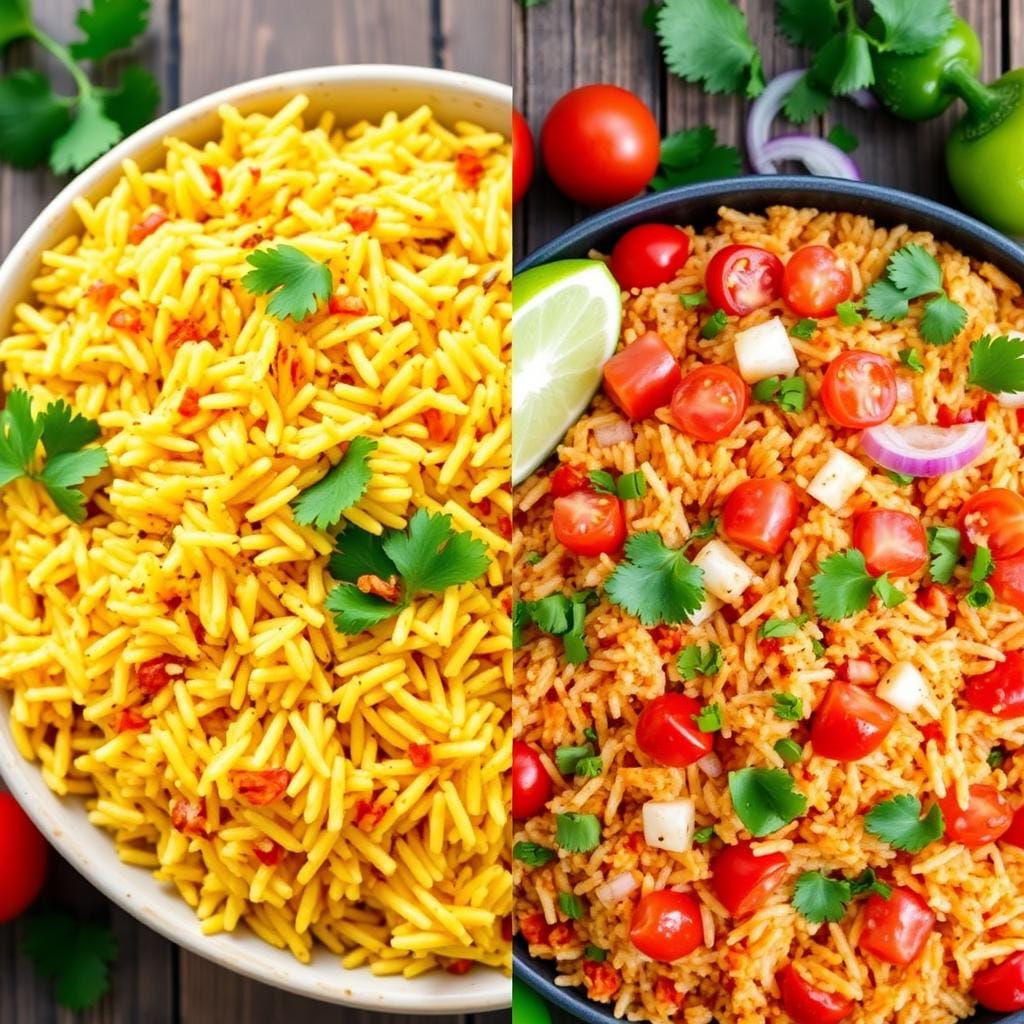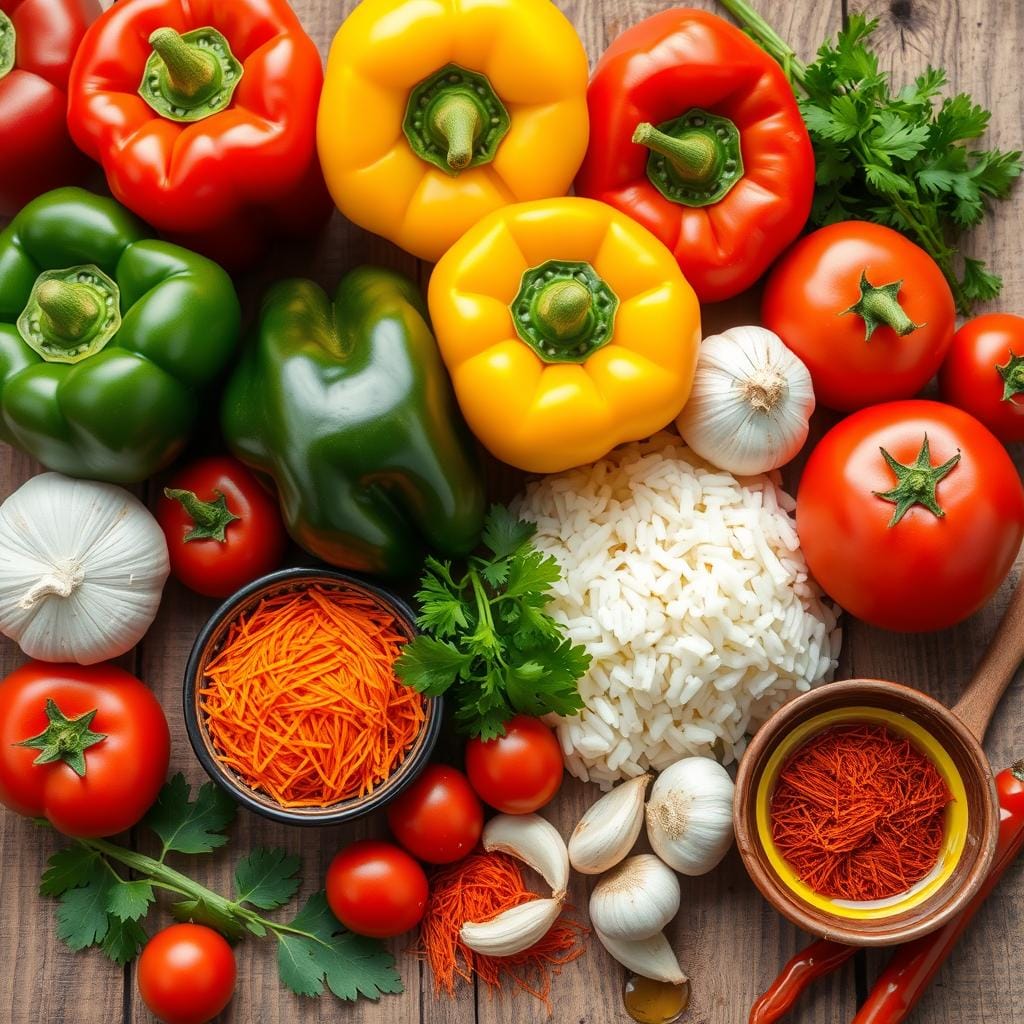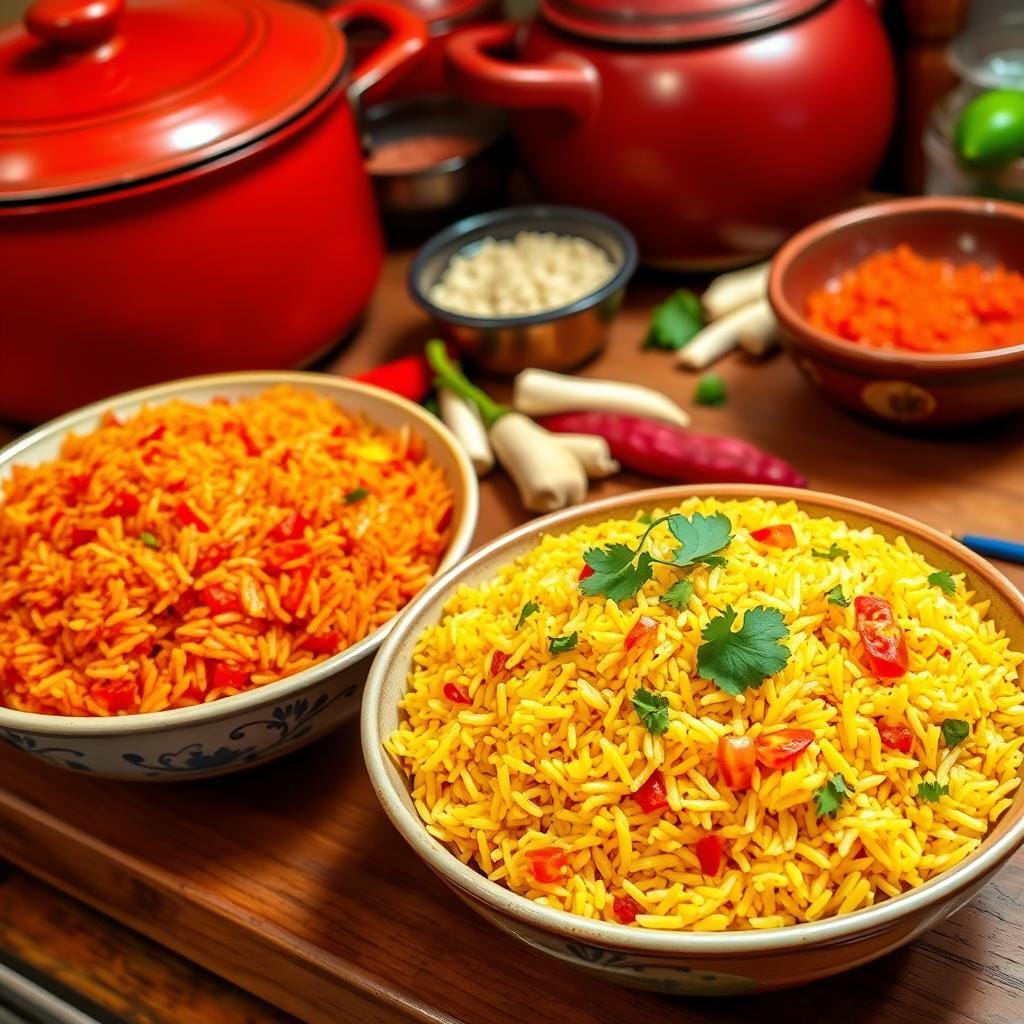I love exploring the world of food and the stories it tells. Today, let’s dive into the tasty world of Spanish rice and Mexican rice. These dishes may seem similar, but they have their own unique flavors and histories. They are a feast for your senses and a chance to learn about different cultures.
Key Takeaways
- Uncover the historical origins and cultural significance of Spanish and Mexican rice dishes.
- Discover the key characteristics that set these two rice varieties apart.
- Learn about the essential ingredients and traditional preparation methods for each cuisine.
- Explore the diverse regional adaptations and modern interpretations of these beloved rice dishes.
- Gain insights into serving suggestions and pairing guidelines to elevate your dining experiences.
Understanding Spanish and Mexican Rice Fundamentals
Spain and Mexico have a rich food heritage. Their rice dishes show how culture and region shape food. These stories take us on a tasty journey through history and taste.
Historical Origins of Both Rice Dishes
Spanish rice comes from the Moors’ influence on Spanish food. They brought rice and cooking ways to the Iberian Peninsula. Mexican rice started with the Aztecs and Spanish, making rice a key part of Mexican food.
Basic Characteristics That Set Them Apart
Spanish rice and Mexican rice both use rice, but they’re different. Spanish rice uses short-grain rice for a sticky texture. Mexican rice uses long-grain rice for a fluffier texture.
Cultural Significance in Each Cuisine
Spanish rice and Mexican rice mean a lot to their cultures. Spanish rice is a key part of Spanish regional specialties. Mexican rice is part of Mexico’s rich culture and diverse cooking ways.
Learning about these rice dishes is more than just food. It shows how culture and history shape our food in Spain and Mexico.
What is the difference between Spanish rice and Mexican rice?
Spanish rice and Mexican rice are often mixed up, but they’re quite different. They have unique flavors and ways of making them. Knowing the difference between Spanish rice and Mexican rice lets you enjoy each dish more.
Spanish rice uses short-grain rice, cooked in olive oil or butter. It’s simmered in a broth with saffron, paprika, and spices. This makes the rice golden and slightly nutty.
Mexican rice uses long-grain rice, toasted in oil or butter. It’s cooked in a tomato broth with onions, garlic, and spices like cumin and chili powder. This gives it a spicy and tangy taste.
| Spanish Rice | Mexican Rice |
|---|---|
| Short-grain or medium-grain rice | Long-grain rice |
| Saffron, paprika, and other aromatic spices | Tomato-based broth, cumin, chili powder, oregano |
| Sautéed in olive oil or butter | Toasted in oil or butter |
| Savory, slightly nutty flavor | Slightly spicy and tangy flavor |
The way these rice dishes are made and enjoyed also matters. Spanish rice comes from the Iberian Peninsula, while Mexican rice is a big part of Mexican food. These differences in flavor profiles and culture make each dish special.

Essential Ingredients Used in Spanish Rice
Spanish rice is known for its unique flavors. The key ingredients, including traditional seasonings and spices, make it special. Together, they create the dish’s distinct taste.
Traditional Spanish Seasonings and Spices
The heart of Spanish rice is its aromatic seasonings and spices. Saffron, from the crocus flower, gives it a golden color and a floral taste. Smoked paprika, or pimentón, adds a smoky and sweet flavor.
Garlic, onions, and tomatoes are also important. They add to the dish’s rich, savory taste.
Key Base Components
- Short-grain or medium-grain rice
- Olive oil for sautéing
- Broth or stock (often chicken or vegetable)
- Tomato sauce or chopped fresh tomatoes
Authentic Spanish Rice Varieties
Though the main ingredients stay the same, Spain’s different regions have their own Spanish rice styles. Arroz a banda from Valencia uses fish stock and seafood like shrimp or clams. Arroz negro, or “black rice,” gets its dark color from squid ink.
These variations show how Spanish rice can be different yet still delicious.

“The essence of Spanish cuisine lies in its ability to transform simple ingredients into culinary masterpieces.”
Traditional Mexican Rice Components and Preparation
Rice is a key part of Mexican cuisine, playing a big role in many favorite dishes. The way Mexican rice is made is special, with a mix of flavors and techniques. It shows the true spirit of Mexican cooking, from the ingredients to the cooking methods.
Key Ingredients for Authentic Mexican Rice
- Long-grain white rice: The base of Mexican rice, giving it the right texture and flavor.
- Tomato sauce or diced tomatoes: They add a red color and a tangy, sweet taste.
- Onions and garlic: These add depth and complexity to the rice.
- Chicken or vegetable broth: It makes the rice richer and tastier.
- Spices: Cumin, chili powder, and oregano give it the Mexican flavor.
Traditional Mexican Rice Preparation Steps
- Sauté the rice in oil or butter until it’s lightly golden, giving it a nutty taste.
- Add the onions and garlic, cooking until they’re fragrant and clear.
- Stir in the tomato sauce or diced tomatoes, broth, and spices, then bring to a boil.
- Lower the heat, cover the pot, and simmer for 15-20 minutes until the rice is tender and the liquid is gone.
- Fluff the rice with a fork, then let it rest for a few minutes before serving.
Making traditional Mexican rice is all about getting each grain to soak up the flavors. This makes it a delicious side dish that goes well with many Mexican dishes.
Cooking Techniques and Methods Compared
Preparing Spanish rice and Mexican rice requires different techniques. Knowing these differences is key to making both dishes taste authentic and flavorful.
Spanish Rice Cooking Process
To make Spanish rice, start by sautéing the rice in oil or butter. This step gives the rice a nutty and aromatic flavor. Then, simmer the rice in a mix of broth, tomatoes, and Spanish seasonings like saffron and garlic until it’s tender.
Mexican Rice Preparation Steps
Mexican rice starts with frying the rice in oil or lard until it’s golden. This step makes the rice crispy on the outside. Next, simmer the rice in a flavorful broth with tomatoes, onions, and Mexican spices like cumin and chili powder.
Common Cooking Mistakes to Avoid
- Don’t overcrowd the pan during sautéing or frying. It can cause uneven cooking and bad texture.
- Always rinse the rice before cooking to avoid sticky and clumped rice.
- Make sure to use the right liquid-to-rice ratio to avoid undercooked or mushy rice.
- Let the rice rest and steam after cooking. It’s essential for fluffy grains.
By understanding the differences in Spanish and Mexican rice preparation, you can improve your cooking. You’ll make delicious and authentic rice dishes that highlight the rice preparation methods and culinary distinctions of these two cuisines.
Color and Appearance Variations
Spanish rice and Mexican rice differ greatly in color and appearance. These differences come from the unique ingredients and cooking methods used in each culture.
Spanish rice is famous for its bright yellow color. This is thanks to saffron, a valuable spice that adds both color and taste. The rice grains in Spanish rice are longer and more individualized. They also have a slightly drier texture than Mexican rice.
Mexican rice, on the other hand, has a reddish-orange color. This comes from tomatoes or tomato sauce used in cooking. The grains of Mexican rice are shorter and more compact. They also have a softer, more moist texture.
These visual differences add to the unique flavor profiles of each dish. They also highlight the cultural significance and traditional presentation of rice dishes in their respective cuisines.
Regional Adaptations and Modern Interpretations
As the culinary world changes, Spanish and Mexican rice dishes have seen big changes. These updates show the rich diversity and cultural influences that make these rice dishes special.
Contemporary Spanish Rice Variations
The traditional Spanish rice is still loved, but new versions have appeared. In Valencia, you find arroz a la valenciana with saffron. In Catalonia, there’s arroz negro, a hearty dish. These new takes highlight local ingredients and cultural influences.
Modern Mexican Rice Innovations
Chefs and home cooks in Mexico are trying new things with rice. They’re adding queso fresco and rajas and even using quinoa or wild rice. These changes show the impact of culture on food.
Whether it’s Spain’s saffron or Mexico’s bold tastes, these changes in rice dishes are exciting. They show how traditions can grow and inspire new dishes.
“The beauty of these rice dishes lies in their ability to reflect the unique cultural tapestry of their regions, while also capturing the universal appeal of a well-executed, flavorful rice preparation.”
Serving Suggestions and Pairing Guidelines
Enjoying spanish cuisine and mexican cuisine is all about how you serve and pair your rice dishes. Spanish rice and Mexican rice are not just tasty on their own. They also go well with many other dishes and ingredients. Here are some tips to help you get the most out of these versatile rice varieties.
For Spanish rice, it’s great as a side to grilled meats, seafood, or roasted veggies. Its light, saffron taste goes well with the deep flavors of Spanish dishes. You can also use it as a base for stuffed peppers, burritos, or paella, showing its kitchen versatility.
Mexican rice is perfect for bold, flavorful dishes. Serve it with grilled or braised meats, enchiladas, tacos, or fajitas for a complete meal. Its strong, tomato flavor matches the spices and textures of Mexican dishes well.
Whether you’re enjoying Spanish rice or Mexican rice, adding toppings and garnishes can make it even better. Some ideas include:
- Freshly chopped cilantro
- Diced tomatoes or salsa
- Sliced avocado or guacamole
- Crumbled cheese, such as queso fresco or cotija
- Toasted nuts or seeds, like pepitas or sliced almonds
By exploring the unique qualities and serving tips for Spanish rice and Mexican rice, you can enhance your cooking. This way, you can fully enjoy the flavors of these iconic rice dishes from around the world.
“The secret to a great rice dish is not just in the ingredients, but in how you present and pair it with the rest of your meal.”
Conclusion
You now understand the differences between Spanish rice and Mexican rice. These dishes share some similarities but have unique qualities. This makes them special in their own ways.
Spanish rice is known for its bright color and strong flavors. It reflects Spain’s rich culture. Mexican rice, on the other hand, brings together vibrant flavors and techniques from Mexican kitchens. This shows the diversity and richness of these traditions.
Whether you like the saffron in Spanish rice or the tomato in Mexican rice, both are delicious. We suggest trying these dishes and exploring different versions. This will help you appreciate the cultural stories behind them. Let your taste guide you as you explore the world of rice dishes.

